 Britain in Middle Ages
Britain in Middle Ages
Early middle ages
A MATURING FEUDALISM. THE DOMESDAY BOOK. THE PLANTAGENET KINGS. CONFLICTS WITH THE CHURCH AND BARONS. RICHARD I, JOHN LACKLAND. MAGNA CARTA LIBERTATA.
Later middle ages
B SIMON DE MONFORT. THE GROWTH OF PARLIAMENT. THE HUNDRED YEARS' WAR. THE BLACK DEATH. THE PEASANTS' REVOLT.
Key words, terms and concepts
1. Feudalism, feudal hierarchy
2. A language gap
3. Domesday book
4. Tenants-in-chief (barons), vassals
5. Freemen, freeholders, cottagers, villeins, serfs
6. To raise money (shield money)
7. To impose taxes, fiscal policy
8. Thomas Becket – the martyr
9. Richard (Coeur-de-Lion), the Lion-Heart
10. John Lackland. Magna Carta – the Great Charter of Liberty (1215)
11. Simon de Montfort. The Parliament
12. The Plague – the black death
13. Poll Tax
14. Wycliffe
15. John Ball, Wat Tyier (1381)
Anglo-Norman Britan
The Norman Conquest did have immediate social, political and cultural implications. The new tough foreign aristocracy captured power and lands. By 1100 (12th c.) there were 500 Norman castles in the English countryside. There was a blow against the Church as well; Saxon bishops were either deposed or replaced by Normans. During the 11th and 12th centuries an apparatus of Government of exceptional effectiveness was established.
England was also drawn into close links with the other side of the Channel. But there was a language gap between the local (Anglo-Saxon) population and the new landowners, of both the Church and the Norman Aristocracy.
Latin was a language of monasteries, Norman French was now the language of law and authority. Inflected English, spoken differently in the various regions remained the language of the people.
The brightest evidence of the situation in the country was the Domesday Book (1086), a survey of England's land and people; according to it Norman society still rested on "lordship, secular and spiritual, and the King, wise or foolish, was the lord of lords, with only Lord in Heaven and the Saints above him.”
Historians have introduced into their interpretation of Norman and other European lordship the term "feudalism", first employed during the 12th century. The term was used in both narrow and broad sense. Narrowly it was related to military (knightly) service as a condition of tenure of land. Broadly it was related to the tenure of land itself, obligation and dependence, as expressed in the term "vassalage". The first relationship focuses on warfare in an age of violence, the second on the use as well as the tenure of land in an age when land was the key to society.
All land in the country belonged to the Crown. The king was the greatest landowner in the country and he parcelled out (gave away) the land to the great landowners who were his tenants-in-chief (barons). The barons held their land as a gift, in return for specified services to the Crown. When barons parceled out their land, they also required knightly services from their tenants. During the reign of William 1170 barons had in their service about 4000 knights who were distinguishable as a social group.
The two social groups were opposed to "the poor men": lords themselves cultivated only a third or two fifths of the arable land in use. The rest was cultivated by various kinds of "peasants" (a controversial term not in use at that time): villeins (41%), cottagers (32%), free holders (14%) the group holding (20% of the land) and serfs (10%) – the group with no land at all. At the time of the Domesday Book, the basic distinction was, however, that all men are either free (free holders) or serfs.
In the 13th century King John (Lackland) (1199-1216) replaced military service of his tenants-in-chief by payments, known as "shield money".
In rural England lords lived in manors which were in their own estates. The peasants, free holders and others lived in villages and hamlets.
The Domesday Book was designed for fiscal purposes to increase and protect the King's revenue.
The full implications of the social, political and cultural changes following the Norman Conquest took time to work themselves out.
They were: a political unification of the country and the centralization of government - a strong royal government, feudal interdependence; the supreme power of the King over all his vassals; the establishment of the feudal hierarchy, a further development of the relationship between the King and the barons, sometimes stormy, sometimes cohesive, an emergence of English common law (from precedent to precedent), the making of Parliament.
The latter two were the most obvious phenomena if we investigate (consider) the historical events chronologically and examine the sequence of monarchs.
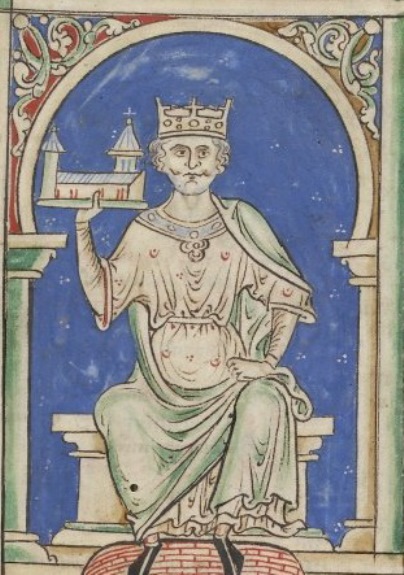
William I The Conqueror
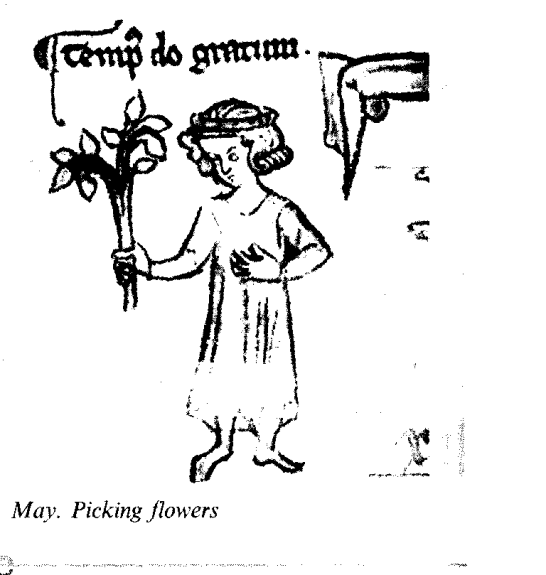
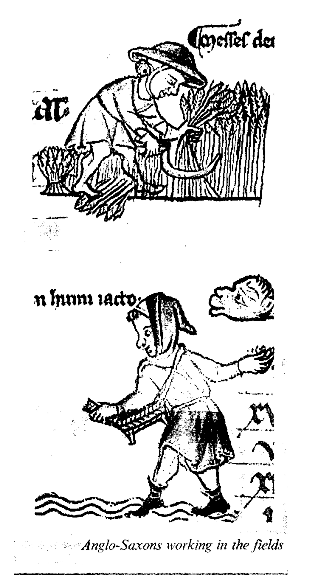
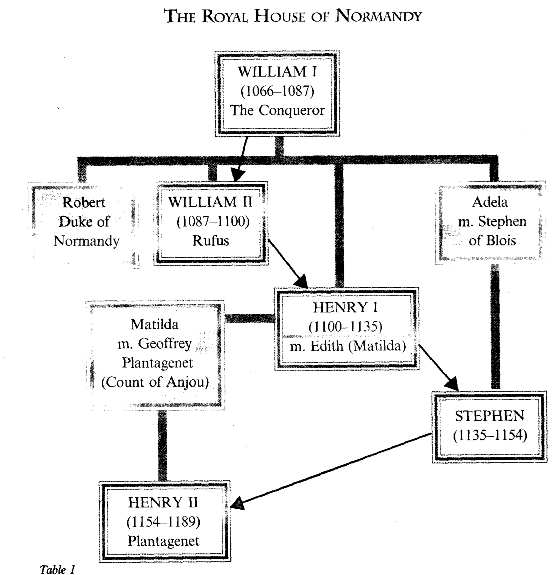
William I The Conqueror (1066-1087) (the Norman Dynasty) died as a result of falling from his horse in a battle in France, was succeeded by his two sons, one after the other:
William II (1087-1100) was cruel but a brave soldier, little loved and little missed when he died.
Henry I (1100-1135) was scholarly and well educated. His daughter was married to the German Emperor Henry V, and later upon his death to Geophrey of Anjou; the son of Geophrey of Anjou (Angevin) became the first Plantagenet*.
* Planta genista – Latin for "broom".
Henry II (1154-1189) was friendly with Thomas Becket, a humble clerk, who was appointed the archbishop of Canterbury. Henry misjudged this man who considered his first loyalty to be the Church and not the King.
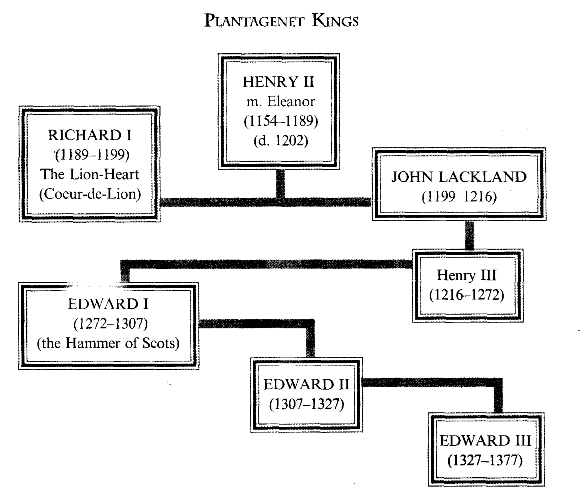

The murder of Thomas Becket in the Cathedral
The conflict ended in the murder of Thomas Becket in his own cathedral by the King's servants. Becket was canonized (St. Thomas); his shrine became a place of pilgrimage for the whole of Europe, for the cures effected there, until it was destroyed by Henry VIII in 1538. So the King of the House of Plantagenet was the first to have a conflict with the Church and he physically destroyed the opposition.
His wife Eleanor took a lively interest in politics. Somewhat too lively at times, for she abetted (helped and supported) her song when they rebelled against their father, she was, as a result, imprisoned.
Henry II's reign was one of constitutional progress and territorial expansion.
Richard I the Lion-Heart (1189-1199).
King Richard may have had the heart of a lion but England saw all too little of him. He was called a romantic sportsman and spent most of his life in Crusades in the Holy Land.
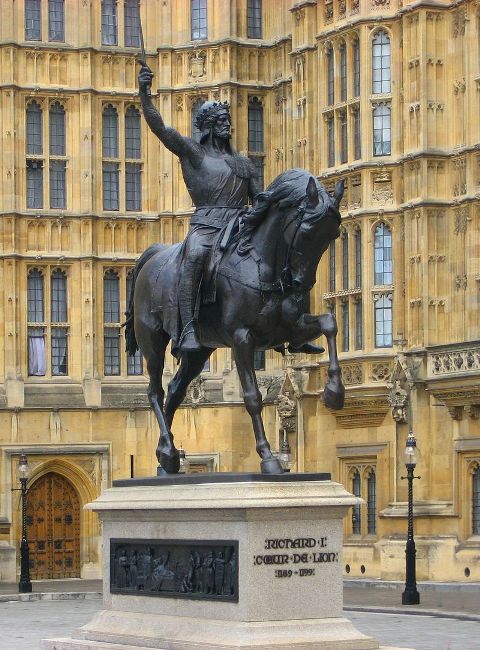
He used England's money to finance his crusades and other adventures, but he was not very lucky – returning from his successful mission, he was captured, and was kept imprisoned in Austria, awaiting the payment of a huge ransom.
He returned to England to stop his younger brother John from usurping the throne, soon after, he rushed to fight King Philip of France who had supported John. Philip was defeated but Richard was killed in a siege of a castle.
His wife who never set foot in England, left no children. So, John (Lackland) (1199-1216), the youngest son of King Henry II, continued the dynasty's rule.
King John Lackland was the most unpopular king: he lost most of his French possessions; he broke his father's heart with his misbehavior, he rebelled against his brother, quarrelled with the Pope, etc. The list of his stupidities and misdemeanours was endless but he did one good thing (or was forced to do it). In 1215 the barons made him seal the Magna Carta, which, though it limited the prerogative of the Crown and extended the powers of the Barons, has since become the foundation stone of an Englishman's liberty.
The pressure on the pocket is more quickly felt than the pressure on the mind - that is why John Lackland was forced by his barons to seal the Magna Carta Libertata (the Great Charter of 1215). Pressed by the demands of war, he had imposed taxes that irritated many of his most powerful subjects. The Magna Carta is a document that dealt with privileges claimed by Norman barons. It was to become part of the English constitutional inheritance, because the baronial claims for liberties were in time translated into the universal language of freedom and justice. It was the beginning of limiting the prerogatives of the Crown.
During the struggle for the Great Charter (Magna Carta) the legions of barons openly opposed the King – disobeyed him, did not pay taxes, raised an army of knights, enjoyed support of townsmen (London supported them), the King was forced to seal the Charter.
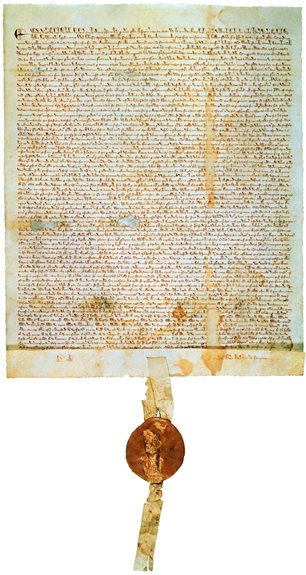
Magna Carta Libertata

The Great Charter of Liberty
It's important to point out that by limiting the King's power, Magna Carta restricted arbitrary actions of barons towards knights and proclaimed the power of law over the free people of the country.
King John was succeeded by his son Henry III (1216-1272). He was not as bad as his father but he was continually short of money and extravagant by nature.
Henry III faced a further development of baronial ambitions and protests. They accused the King of violating their rights and liberties. After a very bad harvest in 1257 Henry III demanded a third of all English property. This aroused a new baronial riot. The barons finally came armed to the Parliament at Oxford and drew up "provisions"–"Oxford Provisions" and additional "Westminster provisions"– to protect the knights from barons which gave all the power in the country to barons. The King and his son did not want to become puppets; and as a result a military conflict developed.
The country was divided into supporters and enemies of the King and a Civil war broke out.
The army of barons was headed (led) by Earl Simon de Montfort and was at first successful in capturing the King's fortresses and castles. They were greeted by townsmen and students of Oxford and church bells.
In 1264 Earl Simon took the King prisoner; in 1265 – Parliament was summoned with "commons" represented in it – two knights from a shire and two merchants from a town.
Prince Edward, Henry's son and heir, (later to succeed Henry as Edward I) rescued Henry. King Henry III managed to defeat Simon de Monfort and killed him in a battle and secured his Crown and his rule.
The 1295 Parliament was called Model Parliament, though it assured a continuity of the 1265 Parliament of Simon de Monfort.
The commons were summoned by the King's Writ to some of the Parliaments (one in eight before 1284; one in three – in the later years of Edward the I's reign, one of which was the so-called Model Parliament of 1295).
The "Oxford Provisions" were not observed by Kings. So, in the 12th and 13th centuries, relationships between the king and the barons, and the making of Parliment were the main historical phenomena of that period.
During the reign of Edward I (1272-1307) there were not only lords, bishops and great abbots present in Parliament, but there were also "commons". This demonstrated the growing wealth and importance of townsmen and knights of the shire not only in the local communities but also in the whole country.
Economics and politics were very closely connected, and the King's main goal in summoning Parliament was to raise money from the population through taxes – 1/10th from people in towns, 1/15th – from the people in the country.
Social relations in the country were undergoing changes in the 13th century. Enforced labour services by villeins were giving way to wage labour, and villeins commuted their labor-dues by paying money to the lord instead. Then the pattern changed: the lords again required labor services. But a lot of villeins were freed, and some of the freed were able, energetic or lucky enough to buy land and prosper as Yomen.
The 13th century was a period of substantial economic activity. Wheat was shipped overseas, but the country's wealth was coming from the exports of wool. Later on, when the wool began to be made into cloth in England, rather than exported as raw material, it stimulated the growth of industry. In the 13th and 14th centuries England was far behind Flanders in the production of cloth but there was enough development.
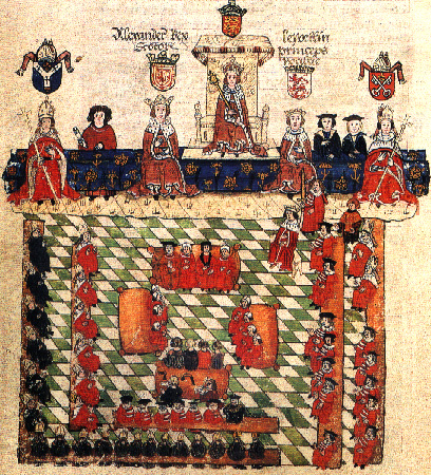
Questions:
1. What were the peculiar traits of the Norman Rule in England?
2. What was the meaning of the term "feudalism" in relation to Norman England?
3. Why was the Domesday book written?
4. What were the political, social, economic and cultural consequences of the Norman Conquest?
5. When was the first conflict of the King with Church?
6. What do you know about the relations in the family of Henry II?
7. What was the first attempt to limit the power of the King? When was it and why?
8. When did the British Parliament appear and how did it develop in the Middle Ages?
9. What were economic and social relations in the early Middle Ages in England?
Later Middle Ages
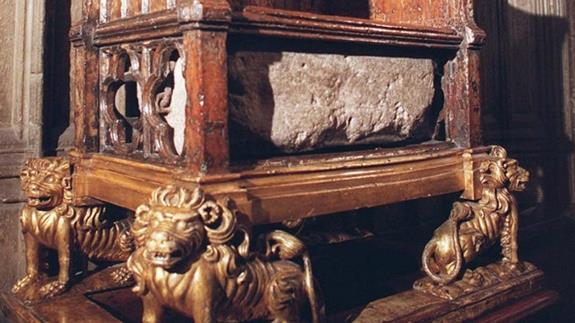
Edward I (1272-1307) was determined to strengthen his royal authority and his Kingdom. To do that he asserted his rule in all territories on the British Isles, especially in Wales and Scotland. He succeeded in imposing English rule on Wales: his son, who was born in a Welsh castle and "could spell not a word of English” at that time, later, in 1301 was created the Prince of Wales and ruler of the principality. Since that time the eldest son of the English monarch has been given that title.
Relationships between England and Scotland were similar to those between England and Wales, but the Scots had a greater degree of independence. Edward I had made several military raids to the Northern kingdom, seized the national treasure – the Stone of Destiny from the Scone Abbey (1296) but had failed to subdue the Scots. Edward I who had been called "the Hammer of Scots" died not far from the border of Scotland during his last abortive campaign to defeat the Scots.
The rule of his son, Edward II (1307-1327) is traditionally characterized as a great failure of the hereditary principles of Monarchy: Edward II had no talent to be a King, but he was the eldest son and succeeded his father. He angered the barons by his foolishness, his extravagance, favourites and military defeats. His reign was a troubled one and he was deposed and forced to abdicate by the barons, assisted by his wife. He died, probably murdered, and was succeeded by his son, Edward III (1327-1377).
Edward III is recognized by historians as a passionate fighter, who was fond of tournaments, chivalry and battles. He instituted the Order of the Garter and cultivated the spirit of chivalry at his court. He pursued a sensible policy of tolerance with barons, thus securing their loyalty. His commercial policies facilitated the development of wool trade and rise of prosperity. But the warrior king was eager to lead his knights in battles, so Scotland was his first rather hard prey as he had failed to subjugate it, though having taken its King David prisoner to England. The dynastic accident helped Edward III to start the Hundred Years' War (1338-1453) which was carried during the reigns of five English Kings.
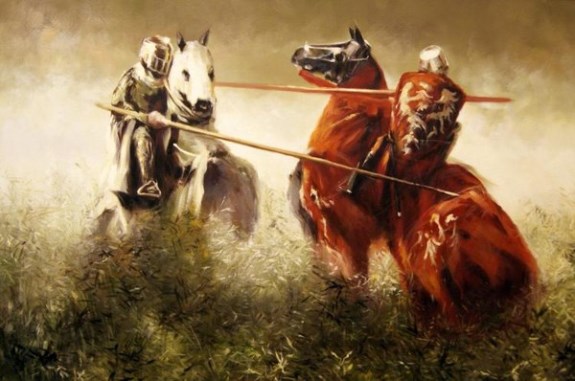
A tournament

A battle in France
Edward declared his claim to the French throne, as his mother had been the sister of Charles IV, king of France, who left no male heir when he died in 1338. This was a respectable enough reason for the war to return the lost English lands in France. The results of the first stage of the war were not as successful as the English had expected them to be. But several victories were won at sea (1340 at Sluys), and in the field – Gascony was recaptured, at Crecy the English archers made the King of France flee from the battle field, Calais after a long siege surrendered in the face of starvation. King Edward's eldest son,– Edward, the Black Prince, a warrior of a high reputation, in 1356 won a victory as Poitiers. In 1348 the outbreak of plague, "the Black death" dealt a terrible blow at the people of Europe and England. It was a terrible disaster, more than 1/3 of the English population died.
The economy and trade of England suffered and the social unrest was spreading due to the results of the economic, social, political and military status. Violence was sparked off by yet another polltax of 1381. People revolted against the tax-collectors and judges, in the south and south-east of England. The rebels, led by Wat Tyler and John Ball, a clergyman, marched to London, captured the Tower with the help of Londoners, killed the archbishop of Canterbury and the Lord Chancellor. John Ball was a radical opponent of the Church-lords and supported the ideas of John Wycliffe, the first reformer of the Church (1330–1384). He preached ideas of social justice: "When Adam delved and Eve Span who was then the gentleman?"

The Peasants' Revolt made far reaching demands: a charter of liberties, the end of all lordship except the King's, the end of serfdom, return of church land to people, etc.
The young King Richard II met the Kentismen face-to-face at Smithsfield. Wat Tyler was pronouncing their demands which were unacceptable to feudalism.
The King appeared to agree but during the negotiations Wat Tyler was treacherously killed and his head, set up on a spear, was shown to the rebels to persuade them to retreat from London and disband. Shocked and morally destroyed they obeyed only to be physically tortured and executed, John Ball was hanged. The punitive actions continued long into autumn. The Great Peasants' Revolt was defeated. But the ruling class had been badly frightened and the unpopular Poll Tax withdrawn.
Through a primitive faith in the King (a kindly king) senior lords prevented the peasants from any attempts to establish their power. But the rebellion undermined the strength and rule of the feudal class and as a consequence few barons dared to refuse the peasants attempts to buy freedom. Actually, peasant dependence in Britain disappeared by the 15th century and the Wat Tyler rebellion was instrumental in that.
King Richard II (1377-1399) after considerable civil struggle, eventually wrested the power from Parliament and the barons. He seems to have pursued a policy of revenge and high-handed despotism.
He brought Duke John of Lancaster's son Henry to England, but Henry gained enough support to take King Richard prisoner and cause him to abdicate in his favour. The House of Lancaster's Henry IV (1399-1413), Henry V (1413-1422), Henry VI (1422-1461)– were followed by the kings of the York family – two Edwards: Edward IV and Edward V, and Richard III, a hunch back, a cruel monster, deformed in body, mind and soul according to the Tudor historians).
There is a statement, that King Richard II was the last King from the House of Plantagenets – he was deposed and dethroned by the House of Lancaster. But it is to be stressed, that the two new royal branches were related to the Plantagenets, were the derivatives of the main stem.
The 13th century was described by historians as a Plantagenet spring after a grim Norman winter. It was the century of the new gothic style in architecture, of Salisbury Cathedral, foundation of universities, the development of the Common Law & the Parliament, and the emergence of English as the language of the nation. The symbol of this spring can be seen in the lyrics "Summer is icumen in". But the following two centuries were filled with wars, discord and discontent.
The 14th century – brought the disasters of the Hundred Years War (1337-1453) the Peasants' Revolt 1381, the extermination of the population by the Black death (1348-1349) and punitive execution of the participants, with positive achievements in literature (Geoffrey Chaucer completes the Canterbury Tales (1393)),– architecture,– and further strengthening of the English language.
The 15th century saw the continuation of the struggle for the crown and the establishment of the Lancaster dynasty in the person of Henry IV, King of England (1399-1414).
Questions:
1. How did Edward I manage to impose English Rule on Wales?
2. What were the English relations with Scotland in the reign of Edward I?
3. What were the military and territorial ambitions of Edward III? Please give the dates of his rule.
4. What were the reasons of social unrest in England in the last quarter of 14th century? Speak of the Great Peasants' Revolt.
5. Why is the destiny of the last Plantagenet King Richard II considered tragic?
6. Please give a concise characteristic of the 14th century.
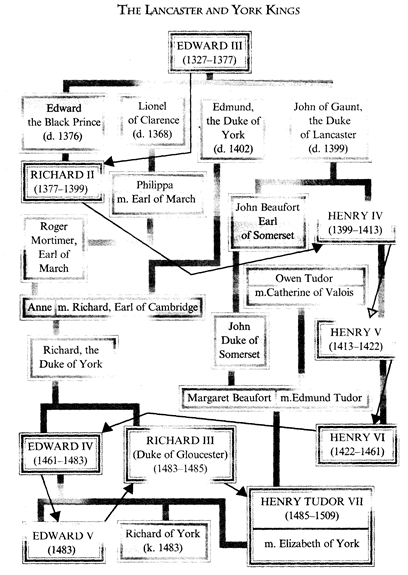
Britain in Late Middle Ages
LANCASTER DYNASTY. WARS OF THE ROSES. THE TRIUMPH OF THE TUDORS. ECONOMIC DEVELOPMENT OF BRITAIN. THE ABSOLUTE MONARCHY OF HENRY VII, TUDOR.
Key words, terms and concepts:
1. Wars of the Roses
2. Indentures
3. Knights and esquires
4. Bastard feudalism
5. Vassals
6. A crest
7. Annihilation
8. Esquire
9. A printing press
10. A village common.
11. To disband baronial armies
12. Controversial arbitrary developments
13. Saint Joan of Arc
The Lancaster Kings continued campaigns in France in the Hundred Years' War: Henry V (1413-1422) was successful in his expeditions in France, Henry VI though having been crowned to Britain and France, lost those French lands and probably Saint Joan of Arc helped the French. Henry VI's reign ended in (1422-1461), confusion, deposition and a cruel war – the Wars of the Roses, a term coined by Sir Walter Scott (1455-1485).
During the Wars of the Roses, great men attached lesser men to their service by lip indentures; the Duke of Lancaster had pointed the way in the late fourteenth century. When he indentured a large number of knights and esquires, most of them were retained for life in his service and in war and peace. Such bastard feudalism as this has been called, was quite different from feudalism. The retainer was not a vassal, who owed loyalty to his lord and was linked to him through ties of mutual obligations. The retainer's lord was his patron, and he was his follower, wearing his livery and being maintained by him.
The Wars of the Roses began when in 1399 barons of the North supported the Lancaster who had a red rose in their crest. The Barons of the South supported the Yorks whose crest was decorated by a white rose. The bloody struggle for the crown and rule practically lasted for about 30 years (1455-1485) with some breaks, it was a merciless annihilation of the old aristocracy with rights and claims to become rulers, and its romantic name the War of the Roses only emphasizes the ruthlessness by a degree of contrast.
Finally, the two dynasties had been destroyed, and a distant relative of the Lancaster family – Henry Tudor married Elisabeth of York in 1485 (the two roses united) and Henry Tudor was crowned Henry VII of England (1485-1509).
The 15th century with its baronial wars though putting brakes on the development of the economy could not stop the progress of productive forces released by the disintegration of dependent feudal relations in agriculture.
The 15th century saw a development of woolen textile manufacture, steel making developed (South Wales, Birmingham and Sheffield), trade development facilitated the growth of the Navy and shipbuilding.
The formation of the common national language manifested itself in fiction and Geoffrey Chaucer (1340-1400) works (Canterbury Tales) and in geographical, commercial, etc. books.
William Caxton (1477) brought a printing press and started book printing in England.
Since the middle of the 15th century the English language became the one working language in the whole of England.
The 15th century saw a development of folklore – ballads of Robin Hood's were dramatized on the village commons; singing and other musical arts, dramatic arts, portrait painting left wonderful examples for us to admire.
So, in the 15th century for all the conflicts, the forces of progress were breaking through, laying foundations for destroying feudalism, for developing capitalism and formation of the English national economy.
Questions:
1. What was the reason of the Wars of the Roses and was it a romantic event?
2. What was the end of this baronial bloodshed and how was the struggle finally finished?
3. What industrial progress was achieved in the 15th century?
4. What were the great cultural achievements of that age?
5. Give a short general outline of the main political, economic and cultural events in the middle ages in Britain.


